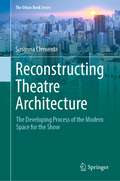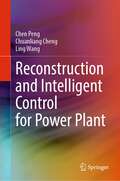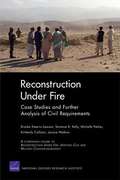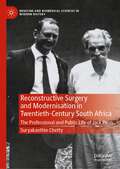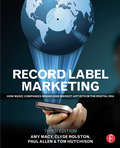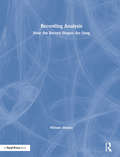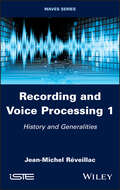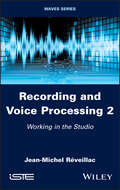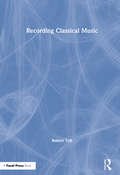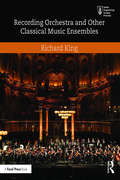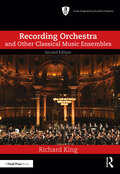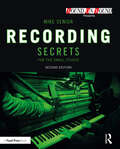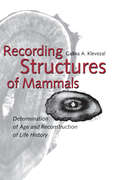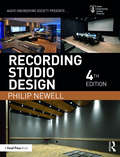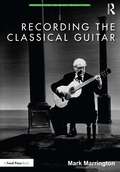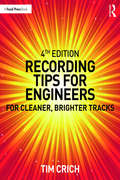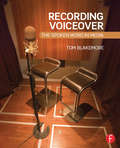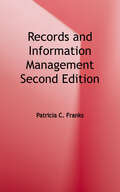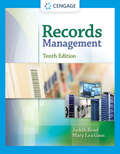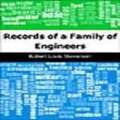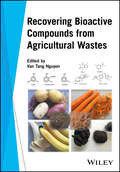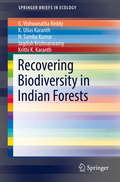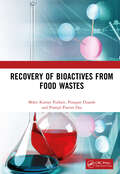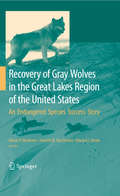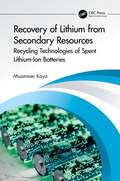- Table View
- List View
Reconstructing Theatre Architecture: The Developing Process of the Modern Space for the Show (The Urban Book Series)
by Susanna ClementeThe study is aimed at reconstructing the historical process at the base of any significant theatre architecture. The modern space for the show is no longer intended as a direct derivation from classical types, but as a product of the transformation of the urban fabric in our cities. The research was conducted at the academies, state and municipal historical archives of numerous towns, in particular Rome, Milan, Mantua, Ferrara, Venice, London and Prague. All images are original. The work also includes the list of about 700 major Italian historical theatres.
Reconstruction and Intelligent Control for Power Plant
by Chen Peng Chuanliang Cheng Ling WangThe authors' innovative research ideas in power plant control are presented in this book. This book focuses on 1) cognition and reconstruction of the temperature field; 2) intelligent setting and learning of power plants; 3) energy efficiency optimization and intelligent control for power plants, and so on, using historical power plant operation data and creative methods such as reconstruction of the combustion field, deep reinforcement learning, and networked collaborative control. It could help researchers, industrial engineers, and graduate students in the areas of signal detection, image processing, and control engineering.
Reconstruction Under Fire: Case Studies and Further Analysis of Civil Requirements
by Kimberly Colloton Michelle Parker Brooke Stearns Lawson Terrence K. Kelly Jessica WatkinsBuilding on a framework for integrating civil and military counterinsurgency (COIN) first presented in prior RAND research, this volume presents an approach to the civil component of counterinsurgency that builds on detailed background, context analysis, and threat analysis to identify and develop critical civil COIN activities and illustrates them with three case studies from Afghanistan, Iraq, and the Democratic Republic of the Congo.
Reconstructive Surgery and Modernisation in Twentieth-Century South Africa: The Professional and Public Life of Jack Penn (Medicine and Biomedical Sciences in Modern History)
by Suryakanthie ChettyThis book traces the career of pioneering South African plastic and reconstructive surgeon, Jack Penn, from its beginnings during the Second World War. It explores the establishment of Penn’s private practice, and his work in diverse countries, including Gabon, Japan and Israel, as he sought to rectify the injury caused by conflict. It also addresses his role on the President’s Council, established by Prime Minister P.W. Botha to introduce reform to the system of apartheid.Penn’s career is contextualised by modernisation which was a significant feature of twentieth-century South Africa. It was linked with race from the inception of the state in 1910 with racial segregation and paternalism. Penn’s work during the Second World War was part of a “modernist” bent by the state under Jan Smuts to take the lead in promoting science and technological development – which continued during apartheid. Modernisation was also fluid with state priority shifting between the two poles of development and security as apartheid policies were met with hostility both within the state and beyond its borders. Within the context of decolonisation, increasing black urbanisation required a balancing act on the part of the state to uphold the ideology of racial distinction while simultaneously addressing economic challenges – and this was reflected in the reform initiatives under Botha.Plastic and reconstructive surgery as evident in the work of Jack Penn is intertwined with this narrative of apartheid, modernisation and reform. It demonstrated Western prowess, with medicine and development a perceived bulwark against Communism. It also served as a means for the modernising apartheid state to initiate, maintain or enhance alliances with other states in the facing of mounting isolation and international condemnation.The career of Jack Penn, then, is a lens through which the contradictions, complexities and anxieties of twentieth-century South Africa are exposed.
Record Label Marketing, 3rd Ed.: How Music Companies Brand and Market Artists in the Digital Era
by Paul Allen Tom Hutchison Amy Macy Clyde Philip RolstonRecord Label Marketing, Third Edition is the essential resource to help you understand how recorded music is professionally marketed. Fully updated to reflect current trends in the industry, this edition is designed to benefit marketing professionals, music business students, and independent artists alike. As with previous editions, the third edition is accessible for readers new to marketing or to the music business. The book addresses classic marketing concepts while providing examples that are grounded in industry practice. Armed with this book, you'll master the jargon, concepts, and language to understand how music companies brand and market artists in the digital era. Features new to this edition include: Social media strategies including step-by-step tactics used by major and independent labels are presented in a new section contributed by Ariel Hyatt, owner of CYBER PR. An in-depth look at SoundScan and other big data matrices used as tools by all entities in the music business. An exploration of the varieties of branding with particular attention paid to the impact of branding to the artist and the music business in a new chapter contributed by Tammy Donham, former Vice President of the Country Music Association. The robust companion website, focalpress.com/cw/macy, features weblinks, exercises, and suggestions for further reading. Instructor resources include PowerPoint lecture outlines, a test bank, and suggested lesson plans.
Recording Analysis: How the Record Shapes the Song
by William MoylanRecording Analysis: How the Record Shapes the Song identifies and explains how the sounds imparted by recording processes enhance the artistry and expression of recorded songs. Moylan investigates how the process of recording a song transforms it into a richer experience and articulates how the unique elements of recorded sound provide essential substance and expression to recorded music. This book explores a broad array of records, evaluating the music, lyrics, social context, literary content and meaning, and offers detailed analyses of recording elements as they appear in a wide variety of tracks. Accompanied by a range of online resources, Recording Analysis is an essential read for students and academics, as well as practitioners, in the fields of record production, song-writing and popular music.
Recording and Voice Processing, Volume 1: History and Generalities
by Jean-Michel RéveillacCapturing, recording and broadcasting the voice is often difficult. Many factors must be taken into account and achieving a true representation is much more complex than one might think. The capture devices such as the position of the singer(s) or narrator(s), the acoustics, atmosphere and equipment are just some of the physical aspects that need to be mastered. Then there is the passage through the analog or digital channel, which disrupts the audio signal, as well as the processes that are often required to enrich, improve or even transform the vocal timbre and tessitura. While in the past these processes were purely material, today digital technologies and software produce surprising results that every professional in recording and broadcasting should know how to master.Recording and Voice Processing 1 addresses some general theoretical concepts. A history of recording and the physiology of the vocal apparatus are detailed in order to give the reader an understanding of the fundamental aspects of the subject. This volume also includes an advanced study of microphones, addressing their characteristics and typologies. The acoustic environment and its treatment are also considered in terms of the location of the sound capture - whether in a home studio, recording studio, live or natural environment - in order to achieve a satisfactory sound recording.
Recording and Voice Processing, Volume 2: Working in the Studio
by Jean-Michel RéveillacCapturing, recording and broadcasting the voice is often difficult. Many factors must be taken into account and achieving a true representation is much more complex than one might think.The capture devices such as the position of the singer(s) or narrator(s), the acoustics, atmosphere and equipment are just some of the physical aspects that need to be mastered. Then there is the passage through the analog or digital channel, which disrupts the audio signal, as well as the processes that are often required to enrich, improve or even transform the vocal timbre and tessitura. While in the past these processes were purely material, today digital technologies and software produce surprising results that every professional in recording and broadcasting should know how to master.Recording and Voice Processing 2 focuses on live and studio voice recordings. It presents the various pieces of hardware and software necessary for voice recording, and details possible sound channel configurations based on recording location. An actual recording, and its various constraints, is then considered, addressing the pitfalls to avoid and the strategies to use in order to achieve a satisfactory result. Different special effects (vocoder, auto-tune, Melodyne, etc.) that can be used on the voice, whether spoken or sung, are also presented.
Recording Classical Music
by Robert ToftRecording Classical Music presents the fundamental principles of digitally recording and editing acoustic music in ambient spaces, focusing on stereo microphone techniques that will help musicians understand how to translate "live" environments into recorded sound. The book covers theory and the technical aspects of recording from sound source to delivery: the nature of soundwaves and their behavior in rooms, microphone types and the techniques of recording in stereo, proximity and phase, file types, tracking and critical listening, loudness, meters, and the post-production processes of EQ, control of dynamic range (compressors, limiters, dynamic EQ, de-essers), and reverberation (both digital reflection simulation and convolution), with some discussion of commercially available digital plugins. The final part of the book applies this knowledge to common recording situations, showcasing not only strategies for recording soloists and small ensembles, along with case studies of several recordings, but also studio techniques that can enhance or replace the capture of performances in ambient spaces, such as close miking and the addition of artificial reverberation. Recording Classical Music provides the tools necessary for anyone interested in classical music production to track, mix, and deliver audio recordings themselves or to supervise the work of others.
Recording Orchestra and Other Classical Music Ensembles (Audio Engineering Society Presents)
by Richard KingRecording Orchestra and Other Classical Music Ensembles explores techniques and methodologies specific to recording classical music. Whether a newcomer or a seasoned engineer looking to refine their skills, this book speaks to all levels of expertise and covers every aspect of recording symphonic and concerto repertoire, opera, chamber music, and solo piano. With a focus on the orchestra as an instrument and sound source, this book features sections on how to listen, understanding microphones, concert halls, orchestra seating arrangements, how to set up the monitoring environment, and how to approach recording each section of the orchestra. Recording Orchestra provides concise information on preparing for a recording session, the role of the producer, mixing techniques, and includes a "quick-start" reference guide with suggested setups aimed at helping introduce the reader to the recording process. A companion website, featuring audio examples of various techniques, reinforces concepts discussed throughout the book. The content of the book includes: Clear, practical advice in plain language from an expert in classical music recording, multiple Grammy award winning recording engineer, and university professor The "secret of recording": a collection of practical recording techniques that have been proven to be highly successful in the field, on many occasions Never before published information written by an industry veteran with over twenty five-years of experience in classical music recording Specific techniques and strategies for recording orchestra, opera, wind symphony, chorus, string quartet, and other common classical music ensembles.
Recording Orchestra and Other Classical Music Ensembles (ISSN)
by Richard KingRecording Orchestra and Other Classical Music Ensembles explores techniques and methodologies specific to recording classical music. Whether the reader is a newcomer or a seasoned engineer looking to refine their skills, this book speaks to all levels of expertise and covers every aspect of recording symphonic and concerto repertoire, opera, chamber music and solo piano.With a focus on the orchestra as an instrument and sound source, Recording Orchestra and Other Classical Music Ensembles features sections on how to listen, understanding microphones, concert halls, orchestra seating arrangements, how to set up the monitoring environment and how to approach recording each section of the orchestra. Offering concise information on preparing for a recording session, the role of the producer and mixing techniques, whilst a "quick-start" reference guide with suggested setups also helps to introduce the reader to the recording process. Online Instructor and Student Resources, featuring audio and video examples of various techniques, further reinforces the concepts discussed throughout the book.This new edition has updated and expanded material, including new chapters on classical crossover projects, film score recording and immersive/3D recording and mixing, as well as a number of new case studies, making this an essential guide for students, researchers and professionals recording classical music.
Recording Secrets for the Small Studio (Sound On Sound Presents...)
by Mike SeniorIn this new edition, discover how to achieve commercial-grade recordings, even in the smallest studios, by applying power-user techniques from the world’s most successful producers. Recording Secrets for the Small Studio is based on the backroom strategies of more than 250 famous names. This thorough and down-to-earth guide leads you through a logical sequence of practical tasks to build your live-room skills progressively from the ground up, with user-friendly explanations that introduce technical concepts on a strictly need-to-know basis. On the way, you’ll unravel the mysteries of many specialist studio tactics and gain the confidence to tackle a full range of real-world recording situations. Specifically designed for small-studio enthusiasts, this book provides an intensive training course for those who want a fast track to releasing quality results, while the chapter summaries, assignments, and extensive online resources are perfect for school and college use. Learn the fundamental principles of mic technique that you can apply in any recording scenario – and how to avoid those rookie mistakes that all too often compromise the sonics of lower-budget productions. Explore advanced techniques which help industry insiders maintain their competitive edge even under the most adverse conditions: creative phase manipulation, improvised acoustics tweaks, inventive monitoring workarounds, and subtle psychological tricks. Find out where you don’t need to spend money, as well as how to make a limited budget really count. Make the best use of limited equipment and session time, especially in situations where you’re engineering and producing single-handed. Pick up tricks and tips from celebrated engineers and producers across the stylistic spectrum, including Steve Albini, Neal Avron, Roy Thomas Baker, Joe Barresi, Howard Benson, Tchad Blake, T-Bone Burnett, Geoff Emerick, Brian Eno, Paul Epworth, Shawn Everett, Humberto Gatica, Imogen Heap, Ross Hogarth, Trevor Horn, Rodney Jerkins, Leslie Ann Jones, Eddie Kramer, Jacquire King, Daniel Lanois, Sylvia Massy, Alan Meyerson, Justin Niebank, Gary Paczosa, Tony Platt, Jack Joseph Puig, David Reitzas, Bob Rock, Laura Sisk, Fraser T Smith, Young Guru, and many more. Now extensively expanded and updated, with new sections on contact mics, software instruments, squash mics, and ensemble depth distortion.
Recording Structures of Mammals
by Galina A. KlevezalThis text focuses on the principles and methods of using growth layers formed in teeth and bones of mammals to make a judgement on essential traits of the animal's life history. In nearly all mammalian species, including man, the age of individuals can be determined from the number of growth layers and, at least in some of them, it is possible to estimate the season of an animal's birth and death, age of sexual maturation, periodicity of reproduction, certain feeding habits and other aspects of the individual's biology. It is also possible, from tooth-enamel analysis, to assess doses of radiation accumulated by animals and human beings during their lifetime.;This book is intended for zoologists, wild-game biologists and zoo archaeologists, but some of the sections could also be of interest for anthropologists, radioecologists and conservation biologists.
Recording Studio Design (Audio Engineering Society Presents)
by Philip NewellRecording Studio Design, Fourth Edition explains the key principles of successful studio design and construction using straightforward language and the use of practical examples appreciated by readers of previous editions. Updated to reflect new industry standards, this fourth edition addresses improvements in cinema sound, with specific attention paid to B-chain electroacoustic response and calibration. Using over 50 years’ experience, author Philip Newell provides detail on the practical aspects of recording in various environments, not only exploring the complex issues relating to the acoustics but also providing real-world solutions. While the book contains detailed discussions about performing rooms, control rooms, and mobile studios, concepts of the infrastructures are also discussed, because no studio can perform optimally unless the technical and human requirements are adequately provided for. In this new edition, sound for cinema provides a platform for highlighting many, wider electroacoustic topics in a way that is relatively easy to visualise. The way in which sound and vision interact is an important aspect of many modern multimedia formats. The new edition includes: A new Chapter 22 that will thoroughly reflect recently published SMPTE investigations which will drastically impact standards for cinema sound; The inclusion of new academic research and its practical applications; An entire new illustrated chapter on room construction principles; and The consolidation of ideas which were only emerging when the earlier editions were published.
Recording the Classical Guitar (Perspectives on Music Production)
by Mark MarringtonRecording the Classical Guitar charts the evolution of classical guitar recording practice from the early twentieth century to the present day, encompassing the careers of many of the instrument’s most influential practitioners from acoustic era to the advent of the CD. A key focus is on the ways in which guitarists’ recorded repertoire programmes have shaped the identity of the instrument, particularly where national allegiances and musical aesthetics are concerned. The book also considers the ways in which changing approaches to recording practice have conditioned guitarists’ conceptions of the instrument’s ideal representation in recorded form and situates these in relation to the development of classical music recording aesthetics more generally. An important addition to the growing body of literature in the field of phonomusicology, the book will be of interest to guitarists and producers as well as students of record production and historians of classical music recording.
Recording Tips for Engineers: For Cleaner, Brighter Tracks
by Tim CrichRecording Tips for Engineers, Fourth Edition provides the knowledge needed to become a proficient audio engineer. With years of experience working with big name rock stars, author Tim Crich shares his expertise and gives all the essential insider tips and shortcuts. A tool for engineers of all levels, this humorous, easy-to-read guide is packed with practical advice using real-life studio situations, bulleted lists, and clear illustrations. It will save valuable time and allow for fast, in-session reference. Additional resources are available on the companion website (www.routledge/cw/crich.com). The fourth edition has been updated to: Lead discussions of modern file storage and processes for uploading, downloading, sharing, and transferring files and data. Address digital audio workstations. Provide expanded coverage on room treatment.
Recording Voiceover: The Spoken Word in Media
by Tom BlakemoreThe only book on the market to specifically address its audience, Recording Voiceover is the comprehensive guide for engineers looking to understand the aspects of capturing the spoken word. Discussing all phases of the recording session, Recording Voiceover addresses everything from microphone recommendations for voice recording to pre-production considerations, including setting up the studio, working with and directing the voice talent, and strategies for reducing or eliminating distracting noise elements found in human speech. Recording Voiceover features in-depth, specific recommendations for recording radio and television commercials, corporate communications, documentaries, tracks for gaming and animation, radio drama, interviews and roundtable discussions. A discussion of the voice in film and television is also included. Special attention is paid to the final release format and its impact on recording strategies. Exploration of using telephone interfaces – including both analogue and digital ISDN, as well as recording across the internet – is included.
Records and Information Management
by Patricia C. FranksAs Information Management put it, "On the strength of its currency and coverage alone, Franks' book is poised to take over as the recommended go-to reference for both students and RIM professionals for many years to come." <p><p>The new second edition cements this work's status as an up-to-date classic, its content updated and expanded to address emerging technologies, most notably blockchain, and evolving standards and practices. Inside, Franks presents complete coverage of the records and information lifecycle model, encompassing paper, electronic (databases, office suites, email), and new media records (blogs, chat messages, and software as a service). <p><p>Informed by an advisory board of experts in the field and with contributions by noted authorities, the text addresses such key topics as the origins and development of records and information; the discipline of information governance and developing a strategic records management plan; creation/capture and classification; retention strategies, inactive records management, archives, and long-term preservation; access, storage, and retrieval; electronic records and electronic records management systems; the latest on rapidly evolving technologies such as web records, social media, and mobile devices; vital records, disaster preparedness and recovery, and business continuity; monitoring, auditing, and risk management; and education and training. <p><p>This book's authoritative blend of theory and practice makes it a matchless resource for everyone in the archives and records management field. Instructor/trainer extras include a set of ready-to-go, customizable PowerPoint slides to accompany the text.
Records Management
by Judith Read Mary Lea GinnRECORDS MANAGEMENT, Tenth Edition, provides a comprehensive introduction to the complex field of records management. The text features sound principles of records and information management that include the entire range of records; physical (paper), image records, and electronic media used in computerized systems. <P><P>Part I, Records and Information Management, provides thorough coverage of alphabetic filing rules, as well as methods of storing and retrieving alphabetic, subject, numeric, and geographic records. The rules agree with the latest standard filing guidelines presented by ARMA International. Part II, Electronic Records Management, introduces electronic records file management as well as classifying electronic files using metadata, taxonomies, and file plans; and the use of magnetic, optical and solid state media through the phases of the records management life cycle. <P><P>A new chapter introduces Enterprise Content Management (ECM) and describes how Microsoft SharePoint is used in Records Management. Part III, RIM Program Administration, delves into the records and information management (RIM) program components and guidelines; with expanded coverage of information governance, social media, and the records and information manager's responsibilities. In addition to content based on ARMA International standards and best practices, the text features realistic database activities, profiles of real-world professionals, and practical advice and examples to prepare students for career success. <P><P>The Tenth Edition features extensive updates, including a restructuring of the chapters to reflect the growing importance of electronic records management.
Records of a Family of Engineers
by Robert Louis StevensonTrajectory presents classics of world literature with 21st century features! Our original-text editions include the following visual enhancements to foster a deeper understanding of the work: Word Clouds at the start of each chapter highlight important words. Word, sentence, paragraph counts, and reading time help readers and teachers determine chapter complexity. Co-occurrence graphs depict character-to-character interactions as well character to place interactions. Sentiment indexes identify positive and negative trends in mood within each chapter. Frequency graphs help display the impact this book has had on popular culture since its original date of publication. Use Trajectory analytics to deepen comprehension, to provide a focus for discussions and writing assignments, and to engage new readers with some of the greatest stories ever told. "Records of a Family of Engineers" by Robert Louis Stevenson recounts the history of the Stevenson family and lighthouse engineering.
Recovering Bioactive Compounds from Agricultural Wastes
by Van Tang NguyenA guide to the extraction, isolation and purification of bioactive compounds from agricultural wastes, and their applications Recovering Bioactive Compounds from Agricultural Wastes offers a guide to the many uses of agricultural wastes from the production of major food types including tea, coffee, cacao, cashew, fruit and vegetables, wine, edible oils, sugar, starch and more. Written by a noted expert in the field, the text explores the various methods for extraction, isolation and purification of bioactive compounds from agricultural wastes. The author also makes recommendations concerning the most effective applications of bioactive compounds and discusses the economics and market for recovered bioactive compounds. Recent studies reveal that bioactive compounds have been directly linked to biological activity such as antioxidant, anticancer, antidiabetic, anti-cardiovascular capacities, etc. In particular, agricultural wastes are considered as potential and inexpensive sources of bioactive compounds. Recovering Bioactive Compounds from Agricultural Wastes fills a gap in the literature by providing a text that explores this important topic and examines the: Sustainability of waste management and shows how to extract, isolate and purify bioactive compounds from agricultural wastes, and their most effective application Wide range of agricultural food produce that can be processed and the special techniques used for recovering the bioactive compounds from these sources Health applications of bioactive compounds that have been directly linked to pharmacological activities including antioxidant, anticancer, and more Designed for use by researchers and producers in the agriculture, pharmaceuticals and nutraceuticals, Recovering Bioactive Compounds from Agricultural Wastes contains the knowledge, history and definition, classification and synthesis, and extraction techniques of bioactive compounds.
Recovering Biodiversity in Indian Forests
by G. Vishwanatha Reddy K. Ullas Karanth N. Samba Kumar Jagdish Krishnaswamy Krithi K. KaranthThis book demonstrates how varying levels of human disturbance manifested through different management regimes influence composition, richness, diversity and abundance of key mammal, bird and plant species, even within ecologically similar habitats. Based on our results, we show the critical importance of the 'wildlife preservation' approach for effective biodiversity conservation. The study also provides examples of a practical application of rigorous methods of quantitative sampling of different plant and animal taxa as well as human influences, thus serving as a useful manual for protected area managers. Protectedareas of various kinds have been established in India with the goal ofarresting decline in, and to provide for, recovery of biodiversity andecosystem services. A model that targets 'wildlife preservation' under stateownership is practiced across the country. However, forests in India are underintensive human pressure and varying levels of protection; therefore, protectedareas may also experience open-access resource use, a model that is beingaggressively advocated as a viable alternative to 'preservationism'. We haveevaluated the conservation efficacy of alternative forest management models byquantifying levels of biodiversity under varied levels of access, resourceextraction and degree of state-sponsored protection in the Nagarahole forestlandscape of southwestern India.
Recovery of Bioactives from Food Wastes
by Mihir Kumar Purkait Prangan Duarah Pranjal Pratim DasThis book is a concise presentation of important aspects involved in dealing with extraction and utilization of bioactive compounds from the food industry waste. It starts with a focus on the global scenario of food waste generation and potential of food waste in various industries. Thereafter, the various conventional and advanced extraction techniques are discussed to highlight on how to separate bioactive compounds from the food waste. The application of industrial food-waste derived bioactive compounds in various emerging sectors are highlighted. Features: Presents critical discussion on various advancement in various extraction processes including future trends. Provides elaborative description of food waste sources and challenges associated with it. Highlights potential of bioactive compounds in various industries. Quantitatively discusses existing as well as new technologies/methodologies. Includes a separate chapter on pertinent policies of various countries. This book is aimed at researchers and graduate students in chemical and food engineering, separation technology and bioactive compounds.
Recovery of Gray Wolves in the Great Lakes Region of the United States: An Endangered Species Success Story
by Adrian P. Wydeven Edward Heske Timothy R. DeelenThe Great Lakes region is unique in that it is the only portion of the lower 48 states where wolves were never extirpated. As the birthplace of some of the first modern concepts of wolf conservation and research, the region is also the first place in the U.S. where "endangered" wolf populations recovered. During this process, much has been learned about wolf biology and ecology, endangered species management, carnivore conservation, landscape ecology, depredation management, and social aspects of wildlife conservation. Recovery of Gray Wolves in the Great Lakes Region of the United States traces wolf recovery in this region and highlights lessons learned by conservationists during the recovery process. Each chapter includes a thorough review of the pertinent literature, in addition to new data and new perspectives and interpretations. The result is both rigorous with respect to science and policy and accessible and interesting for the lay reader. The story of wolf recovery in the Great Lakes region is one of international significance for conservationists.
Recovery of Lithium from Secondary Resources: Recycling Technologies of Spent Lithium-Ion Batteries
by Muammer KayaRecovery of Lithium from Secondary Resources: Recycling Technologies of Spent Lithium-Ion Batteries presents a state-of-the-art review of recent advances in the lithium recovery from spent lithium-ion batteries (LIBs). It examines the recovery of lithium from secondary sources and provides an introduction to the classification and structure of LIBs. It explains the development of LIBs for electric vehicles and addresses the potential impact of spent LIBs in the environment. Further, it also addresses the multiple treatment protocols for the recycling of LIBs and discusses the high value-added products from these processes. The book provides an essential resource for professionals, researchers, and policymakers in academia, industry, and governments around the globe.
